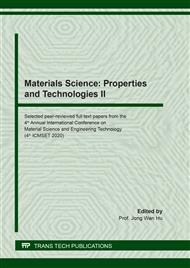[1]
J.-M. Yan, X. B. Zhang, T. Akita, M. Haruta, Q. Xu, One-Step Seeding Growth of Magnetically Recyclable Au@Co Core−Shell Nanoparticles: Highly Efficient Catalyst for Hydrolytic Dehydrogenation of Ammonia Borane, J. American Chem. Soc. 132(15) (2010) 5326-5327.
DOI: 10.1021/ja910513h
Google Scholar
[2]
R. J. H. Grisel, B. E. Nieuwenhuys, Selective Oxidation of CO, over Supported Au Catalysts, J. Catalysis, 199(1) (2001) 48-59.
DOI: 10.1006/jcat.2000.3121
Google Scholar
[3]
N. Lopez, T. V. W. Janssens, B. S. Clausen, Y. Xu, M. Mavrikakis, T. Bligaard, J. K. Nørskov, On the origin of the catalytic activity of gold nanoparticles for low-temperature CO oxidation, J. Catalysis, 223(1) (2004) 232-235.
DOI: 10.1016/j.jcat.2004.01.001
Google Scholar
[4]
S. Lal, S. E. Clare, N. J. Halas, Nanoshell-Enabled Photothermal Cancer Therapy: Impending Clinical Impact, Accounts Chem. Res. 41(12) (2008) 1842-1851.
DOI: 10.1021/ar800150g
Google Scholar
[5]
Y. Wang, X. Xie, X. Wang, G. Ku, K. L. Gill, D. P. O'Neal, G. Stoica, L. V. Wang, Photoacoustic Tomography of a Nanoshell Contrast Agent in the in Vivo Rat Brain, Nano Lett. 4(9) (2004) 1689-1692.
DOI: 10.1021/nl049126a
Google Scholar
[6]
T. Zhang, G. Lu, W. Li, J. Liu, L. Hou, P. Perriat, M. Martini, O. Tillement, Q. Gong, Optimally Designed Nanoshell and Matryoshka-Nanoshell as a Plasmonici-Enhanced Fluorescence Probe, J. Phys. Chem. C 116(15) (2012) 8804-8812.
DOI: 10.1021/jp2125944
Google Scholar
[7]
J. Wang, G. Wang, J. Zhao, Density-functional study of Aun(n=2–20) clusters: Lowest-energy structures and electronic properties, Phys. Rev. B 66(3) (2002) 035418.
Google Scholar
[8]
J. Li, X. Li, H. J. Zhai, L. S. Wang, Au20: A Tetrahedral Cluster, Sci. 299(5608) (2003) 864-867.
Google Scholar
[9]
A. Corma, P. Concepción, M. Boronat, M. J. Sabater, J. Navas, M. J. Yacaman, E. Larios, A. Posadas, M. A. López-Quintela, D. Buceta, E. Mendoza, G. Guilera, A. Mayoral, Exceptional oxidation activity with size-controlled supported gold clusters of low atomicity, Nat. Chem. 5(9) (2013) 775-781.
DOI: 10.1038/nchem.1721
Google Scholar
[10]
O. Warshavski, L. Minai, G. Bisker, D. Yelin, Effect of Single Femtosecond Pulses on Gold Nanoparticles, J. Phys. Chem. C 115(10) (2011) 3910-3917.
DOI: 10.1021/jp110348x
Google Scholar
[11]
S. Goel, A. E. Masunov, Density functional theory study of small nickel clusters, J. Molecular Model. 18(2) (2011) 783-790.
DOI: 10.1007/s00894-011-1100-x
Google Scholar
[12]
S. Heiles, A. J. Logsdail, R. Schafer, R. L. Johnston, Dopant-induced 2D-3D transition in small Au-containing clusters: DFT-global optimisation of 8-atom Au-Ag nanoalloys, Nanoscale, 4(4) (2012) 1109-1115.
DOI: 10.1039/c1nr11053e
Google Scholar
[13]
G. Bravo-Pérez, I. L. Garzión, O. Novaro, Ab initio study of small gold clusters, J. Molecular Struct. THEOCHEM, 493(1-3) (1999) 225-231.
DOI: 10.1016/s0166-1280(99)00243-2
Google Scholar
[14]
D. M. Benoit, B. Madebene, I. Ulusoy, L. Mancera, Y. Scribano, S. Chulkov, Towards a scalable and accurate quantum approach for describing vibrations of molecule–metal interfaces, Beilstein J. Nanotechnol. 2 (2011) 427-447.
DOI: 10.3762/bjnano.2.48
Google Scholar
[15]
M. Frisch, G. Trucks, H. B. Schlegel, G. Scuseria, M. Robb, J. Cheeseman, G. Scalmani, V. Barone, B. Mennucci, G. Petersson, Gaussian 09, Revision A.02, Gaussian. Inc., Wallingford, CT 200 (2009).
Google Scholar
[16]
J. P. Perdew, J. A. Chevary, S. H. Vosko, K. A. Jackson, M. R. Pederson, D. J. Singh, C. Fiolhais, Atoms, molecules, solids, and surfaces: Applications of the generalized gradient approximation for exchange and correlation, Phys. Rev. B 46(11) (1992) 6671-6687.
DOI: 10.1103/physrevb.46.6671
Google Scholar
[17]
S. Chiodo, N. Russo, E. Sicilia, LANL2DZ basis sets recontracted in the framework of density functional theory, J. Chem. Phys. 125(10) (2006) 104107.
DOI: 10.1063/1.2345197
Google Scholar


